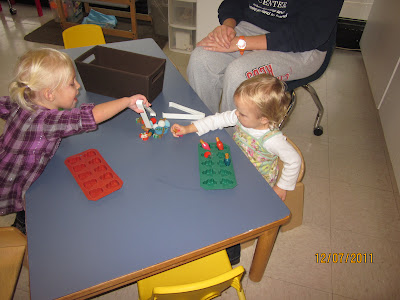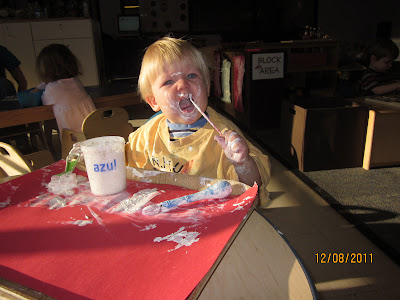The holidays are just around the corner and this is the one time of year that I do a product-oriented, rather than process-oriented, art activity with the children. I do like to have them make a gift to give their parents so we started working on our
hand print mittens today. Granted, we are not getting as fancy as some I have found on-line but, I do feel that is cruel to just paint a toddler's hand white, make the print and then have them go wash their hand without a chance to actually explore the paint. So we are making white paintings this week and at some point in the process, we are helping the children make their hand print.
J was one of the first children to have a turn so he and D got to choose their paint tools. They each chose a texture brush, roller and a regular roller. I gave them their paint and they set to work. As D finished, I painted his hand and he made his print, then went to wash. J saw and wanted to make his so I painted his hand. He squealed in delight when he saw the print left behind and exclaimed, "Do it again!"
We made three prints then ran out of room so I offered him another paper. He decided I needed a turn so I let him paint my hand and made my hand print. He did this several times, squealing in delight with each new print. Eventually the hand prints became a basketball, soccer ball, hot dog and a few other things. I have a feeling he will be trying this again!

We love to get outside with the children but since it has rained for two straight days, our play ground looks more like a river. The water is way too deep for us to go out without rain gear, which we don't have at this point. But, the advantage to being on a college campus is that we can always get out and explore campus. We gathered up coats for the two's, took them in the hallway to put them on then headed out to explore. The one's got to go in the stroller for a walk on their own later so we all got out today for a bit. Once we got out the door of our building, we asked them which direction then followed them. I love that this group is so easy-going that we can let them go for walks without holding hands. They stayed close to us and if we needed to stop, they did and waited for the rest to catch up. We walked up all the steps to main plaza.
We walked, or rather ran, all the way to the other side of campus.
We stopped along the way to check out a sewer.
We ducked into the library during class change time (the plaza gets super-crowded so we wanted to be out of the fray) to visit the dinosaur car. N says someone needs to drive it (probably him!).
On the way to see the ducks, we stopped in the Fine Arts Center to see if we could hear any music. A student was gracious enough to open up a practice room and let the children bang, boom, boom, boom, on the tympani drums, steel drums and the big bass drum.
This was probably the highlight of the trip. We have a group of music lovers who would start their own band if they could. Drums happen to be their favorite.
Then it was over to the lake, across the bridge to visit the ducks and back up the steps on the other side.
On the way back from visiting the ducks, we stopped to investigate a worm on the sidewalk.
I love watching them on campus. They run around there like they own the place and they love to explore it. I truly believe hope that their comfort on campus instills a love of learning and desire to explore for years to come!



















































